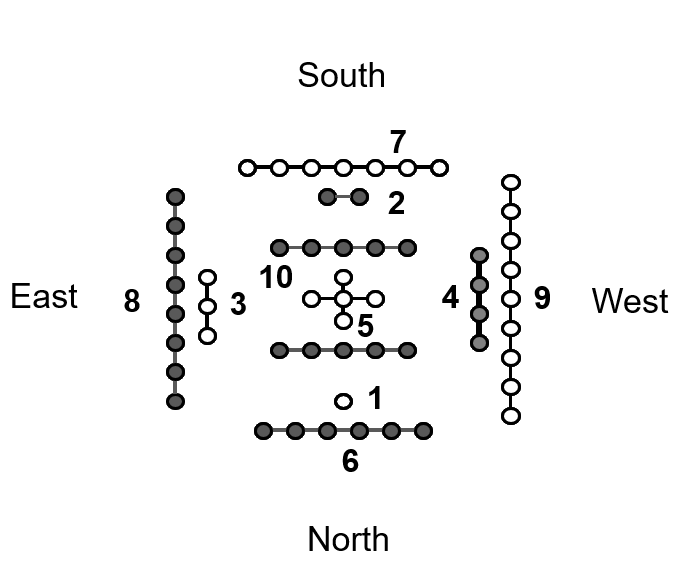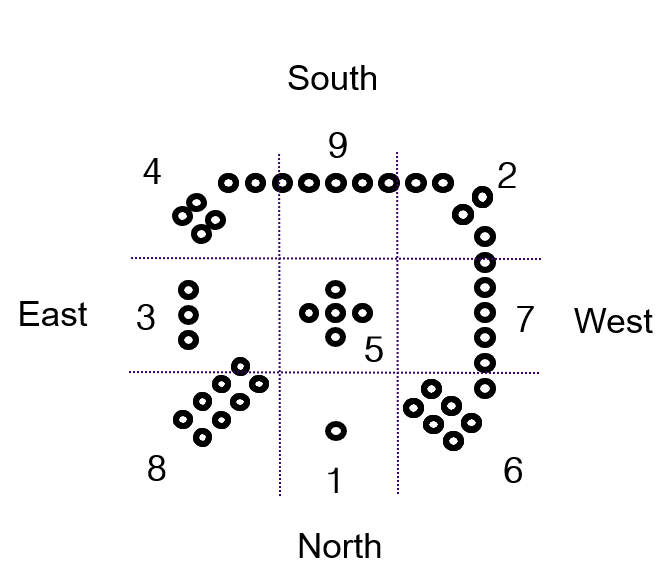The Ho Tu (Yellow River Map) as an Origin of Eastern Cosmology
Historical Context and Discovery
To explore the origin of Eastern cosmology, we should see the Chinese history that spans the eras of the Three Sovereigns and Five Emperors, culminating in the well-documented Xia, Yin (or Shang), and Zhou Dynasties. The story of the Ho Tu begins with the mythical figure Fuxi, one of the Three Sovereigns, who discovered a system of numbers from 1 through 10 on a dragon horse’s back emerging from the Yellow River. This event is depicted in the legendary Ho Tu (河圖).
Cosmological Significance and Development
Inspired by the natural phenomena observed between heaven and earth, Fuxi translated these numbers into a set of images that later formed the basis of the 64 Hexagrams. As the Yin Dynasty waned, Wen Wang, who posthumously assumed kingship, and his son Zhou Gong further expanded on this system through their commentaries on the Hexagrams and the 384 Lines, respectively. These texts collectively are known as the Zhou Yi (周易).
The Ho Tu Diagram
The Ho Tu is visualized as a diagram featuring a specific arrangement of 55 points, numbered 1 to 10, aligned in four cardinal directions. While the diagram appears simple, it encapsulates the foundation for significant philosophical concepts like the I Ching and the interconnected theories of Yin-Yang and the Five Phases.

The Lo Shou (Lo River Map) as another Origin of Eastern Cosmology
Discovery during the Xia Dynasty
The Lo Shou map’s origins trace back to around 2050 BC during King Yu’s reign when a tortoise with a unique, 45-point pattern on its shell was found in the Lo River, upstream from the Yellow River. This pattern is known as the Lo Shou (洛書), as illustrated in the following Figure.

Unique Configuration and Interpretation
Unlike the Ho Tu, the Lo Shou map centers on five points rather than ten and portrays a stark contrast in the arrangement of Yin (even numbers) and Yang (odd numbers). This layout suggests a distinct cosmological perspective focused on the dynamics of opposing forces rather than harmonious transitions.
The Lo Shou Map
The Lo Shou represents a more confrontational relationship between elements, with a counterclockwise movement where elements such as Fire follow Water, indicating conflicting flows and a struggle between condensation and diffusion.
Complementary Insights from Ho Tu and Lo Shou
Both maps, through their unique configurations and numeric symbolism, collectively embody 100 points (55 from the Ho Tu and 45 from the Lo Shou), representing the wholeness of the universe. Each map, with its numeric and elemental symmetries, offers a nuanced understanding of how ancient Eastern cultures viewed the cosmos.
These ancient diagrams not only reflect the numbers but also the philosophical and metaphysical principles they represent. The Ho Tu and Lo Shou maps serve as gateways to understanding the foundational principles of mutual generation and opposition, providing a comprehensive view of life’s cyclical nature and the interplay of visible and invisible forces that govern existence.
The Numerical Mystique of Eastern Cosmology: The Connection Between Natural Numbers and the Five Phases
The Ho Tu (Yellow River Map): Numerical Foundations and Cosmic Reflections
Foundational Numbers and Their Cosmic Roles
In the realm of Eastern cosmology, as depicted by the Ho Tu, the numbers 1 through 10 aren’t just markers on a scale; they embody the full spectrum of numerical and cosmological principles. The first five numbers—1, 2, 3, 4, and 5—hold a special place as they are considered the numbers of creation. Each of these numbers interacts with the central number 5 in a way that symbolizes the universe’s economical operation:
- 6 = 5 + 1
- 7 = 5 + 2
- 8 = 5 + 3
- 9 = 5 + 4
- 10 = 5 + 5
This unique mathematical relationship showcases how subsequent numbers are built upon the foundational five, representing the universe’s tendency towards simplicity and efficiency. The numbers 6 through 10 are hence viewed as the numbers of completion, signifying the culmination and fulfillment of the processes initiated by the first five.
Dynamic Interplay of the Five Phases
Each number also aligns with the Five Phases or Wu Xing, which include Wood, Fire, Earth, Metal, and Water—key elements that explain various natural phenomena and interactions:
- 1 (Water): Symbolizes a condensed whole, like a seed, possessing Yang (positive) qualities.
- 2 (Fire): Represents dispersion and the outward movement of energy.
- 3 (Wood): Acts as a mediator, harmonizing the opposing qualities of 1 and 2.
- 4 (Metal): Transforms expansive states back to condensed forms, rounding out the interplay of energies.
- 5 (Earth): Serves as the neutralizer, balancing the opposing forces within the cosmos.
This numbering not only maps out a theory of elemental interaction but also mirrors the fundamental movements and changes within the universe and nature.
The Lo Shou (Lo River Map): Elemental Oppositions and Numerical Symmetry
Elemental and Numerical Contrasts
The Lo Shou presents a contrasting perspective where elements associated with condensation (Yin) such as Water and Metal face off against those linked with diffusion (Yang) like Wood and Fire. This map highlights a different aspect of cosmic balance, emphasizing survival competition and the principle of mutual overcoming, where one state dynamically suppresses another.
Numerical Integration and Cosmic Balance
Both the Ho Tu and the Lo Shou interlock in a mystical numerical dance, with their combined figures summing to 100, symbolizing completeness and universal unity. Each map, through its distinct numerical arrangements, reflects profound principles of Eastern thought:
- The Lo Shou’s absence of the central ten (found in the Ho Tu) hints at its focus on direct opposition rather than harmonious flow.
- The numbers in both maps, especially those forming symmetrical patterns around the center, signify the constant balancing act between Yin and Yang energies, each set totaling 20, which underscores the balance achieved through these interactions.
Complementary Cosmic Insights
Together, the Ho Tu and Lo Shou do not merely represent static models of the universe but are dynamic frameworks that facilitate a deeper understanding of how fundamental and application principles in Eastern cosmology interact. They provide a comprehensive narrative on how natural numbers and the Five Phases coalesce to depict a universe governed by harmony, opposition, and continual transformation.
This exploration of natural numbers and the Five Phases through the lens of the Ho Tu and Lo Shou maps opens up a rich tapestry of insights into the ancient Eastern worldview, revealing a universe intricately composed of numbers that are as philosophical as they are mathematical.

